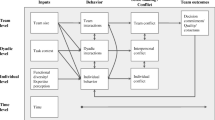If sociological game theory is not to end up as an artificial exercise, … ,
it is absolutely essential that the beliefs, ideas and experiences
of the actors themselves are moved onto center stage
R. Swedberg 2001, p. 325
Abstract
This paper presents a synthetic approach for generating role playing simulation games intended to support analysts (and trainees) interested in testing alternative competing courses of action (operations) and discovering what effects they are likely to precipitate in potential ethno-political conflict situations. Simulated leaders and followers capable of playing these games are implemented in a cognitive modeling framework, called PMFserv, which covers value systems, personality and cultural factors, emotions, relationships, perception, stress/coping style and decision making. Of direct interest, as Sect. 1.1 explains, is mathematical representation and synthesis of best-of-breed behavioral science models within this framework to reduce dimensionality and to improve the realism and internal validity of the agent implementations. Sections 2 and 3 present this for leader profiling instruments and group membership decision-making, respectively. Section 4 serves as an existence proof that the framework has generated several training and analysis tools, and Sect. 5 concludes with lessons learned. Part II turns to the question of assessment of the synthesis and its usage in course of action studies.
Similar content being viewed by others
Explore related subjects
Discover the latest articles, news and stories from top researchers in related subjects.References
Armstrong JS (2002) Assessing game theory, role playing and unaided judgment. Int J Forecast 18:345–352
Bharathy G (2006). A knowledge engineering based systems methodology for integrating of social science frameworks for modeling agents with cognition, personality and culture. Dissertation, University of Pennsylvania
Buckley W (1967) Sociology and modern systems theory. Prentice-Hall, Englewood Cliffs
Camerer C (2003) Behavioral game theory. Princeton University Press, Princeton
Canella AA, Monroe MJ (1997) Contrasting perspectives on strategic leaders: toward a more realistic view of top managers. J Manag 23(3):213–230
Chemers MM (1997) An integrative theory of leadership. Lawrence Erlbaum, Mahwah
Cilliers P (1998) Complexity and postmodernism: understanding complex systems. Routledge, London
de Marchi S (2005) Computational and mathematical modeling in the social sciences. Cambridge University Press, Cambridge
Eidelson RJ, Eidelson JI (2003) Dangerous ideas: five beliefs that propel groups toward conflict. Am Psychol 58:182–192
Geib C (2004). Assessing the complexity of plan recognition. In: Proceedings of AAAI-2004
Green KC (2002) Forecasting decisions in conflict situations: a comparison of game theory, role playing and unaided judgment. Int J Forecast 18:321–344
Hermann MG (1999) Assessing leadership style. Social Science Automation, Hilliard
Heuer RJ Jr (1999) Psychology of intelligence analysis. Center for the Study of Intelligence, Central Intelligence Agency, Washington
Hirschman AO (1970) Exit, voice, and loyalty. Harvard University Press, Cambridge. www.geert-hofstede.com
Hofstede G (2003) Culture’s consequences, comparing values, behaviors, institutions, and organizations across nations. Sage, Newbury Park
House RJ, Hanges PJ, Javidan M et al. (2004) Culture, leadership, and organizations: the GLOBE study of 62 societies. Sage, Thousand Oaks
Johns M (2006). Deception and trust in complex semi-competitive environments. Dissertation, University of Pennsylvania
Kaminka GA, Avrahami D (2004). Symbolic behavior-recognition. In: 3rd international joint conference on autonomous agents and multi-agent systems (AAMAS). NYC, 19–23 July 2004
Kautz HA, Allen JF (1986) Generalized plan recognition. In: AAAI 86. AAAI, Mtn View, pp 32–37
Kojima H (2004, June). Interview. Game Informer, p 42
McDonald D, Lazarus R, Leung A et al (2006) Interoperable human behavior models for simulations. In: 15th conf. on behavioral representation in modeling and simulation (BRIMS). SISO, May 2006
Ortony A, Clore GL, Collins A (1988) The cognitive structure of emotions. Cambridge University Press, Cambridge
Pew RW, Mavor AS (1998) Modeling human and organizational behavior: application to military simulation. Academic, Washington
Silverman BG (2005). Human performance simulation. In: Ness J, Ritzer D, Tepe V (eds) The science and simulation of human performance (Chap 9). Elsevier, New York
Silverman BG, Rees R et al. (2005, May) Athena’s prism: a diplomatic strategy role playing game for generating ideas and exploring alternatives. In: Proceedings of international conference on intelligence analysis. Mitre, MacLean
Silverman BG, Johns M, Cornwell J, O’Brien K (2006a) Human behavior models for agents in simulators and games: part I—enabling science with PMFserv. Presence 15(2):139–162
Silverman BG, O’Brien K, Cornwell J (2006b) Human behavior models for agents in simulators and games: part II—gamebot engineering with PMFserv. Presence 15(2):163–185
Silverman BG, Bharathy G, Nye B et al (2007). Socio-cultural games for training and analysis. IEEE SMC
Simari GI, Parsons S (2004) On approximating the best decision for an autonomous agent. In: 3rd AAMAS conference, W16: workshop on game theory and decision theory, NYC
Swedberg R (2001) Sociology and game theory. J Theory Sociol 30(3):301–335
Uhl-Bien M, Marion R, McKelvey B (in press) Complexity leadership theory: shifting leadership from the industrial age to the knowledge era. Acad. Manag. Rev. (under review)
van Lent M, McAlinden R, Brobst P et al (2004) Enhancing the behaviorial fidelity of synthetic entities with human behavior models. In: 13th conference behavior representation in modeling and simulation (BRIMS). SISOstandards.org, Arlington, VI, 12–15 May 2004
Watson S, Buede D (1987) Decision synthesis. Cambridge University Press, Cambridge
Woodcock S (2002) Game AI: the state of the industry 2001–2002. Game Developer 9(7):31
Author information
Authors and Affiliations
Corresponding author
Rights and permissions
About this article
Cite this article
Silverman, B.G., Bharathy, G., Nye, B. et al. Modeling factions for “effects based operations”: part I—leaders and followers. Comput Math Organiz Theor 13, 379–406 (2007). https://doi.org/10.1007/s10588-007-9017-8
Published:
Issue Date:
DOI: https://doi.org/10.1007/s10588-007-9017-8




